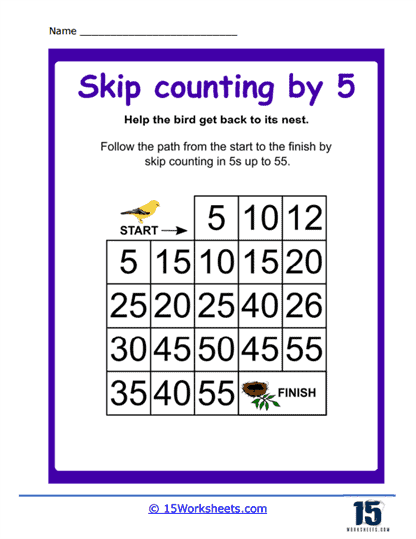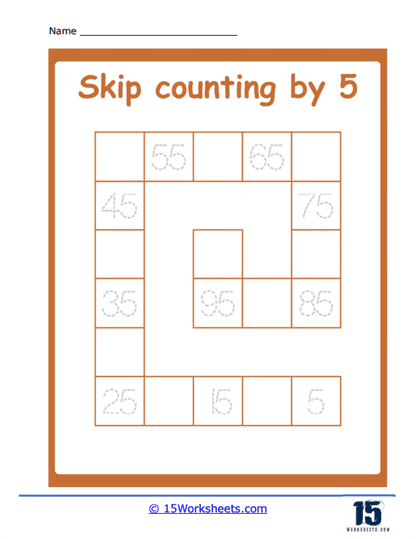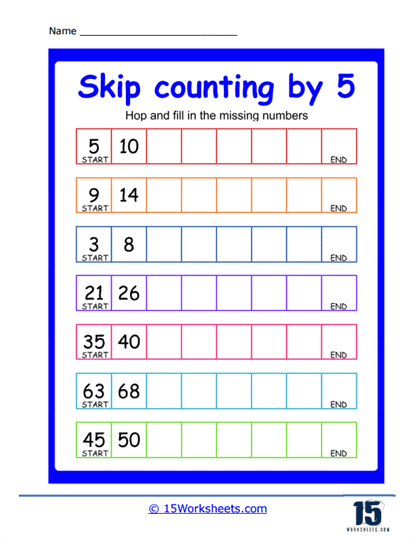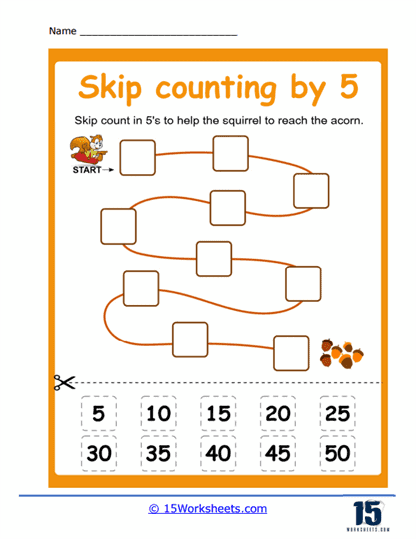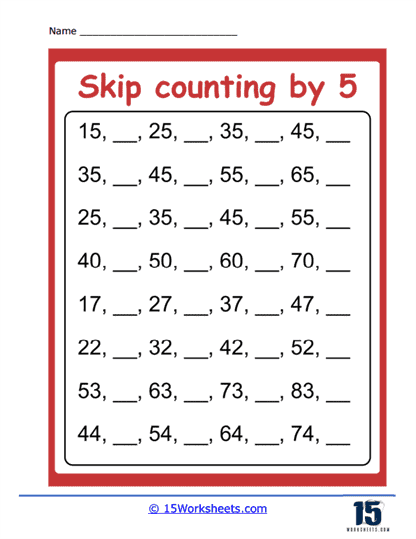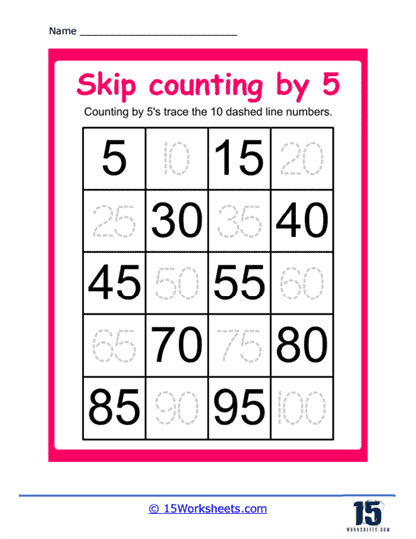Skip Counting By 5 Worksheets
About These 15 Worksheets
This collection of worksheets, centered on skip counting by 5s, provides a diverse set of activities designed to reinforce numerical sequencing skills in young learners. The visual appeal and interactive nature of these sheets target foundational math concepts while keeping students engaged through fun themes, such as mazes, patterns, and colorful illustrations. Each worksheet encourages active participation, whether through filling in missing numbers, tracing, pasting, or following paths, which enhances students’ understanding of number patterns.
The primary skill being developed here is skip counting by 5s, a critical mathematical competency that builds a foundation for multiplication, division, and broader number sense. Skip counting fosters a deeper understanding of numerical relationships, pattern recognition, and aids in mental math strategies. It also prepares students for more advanced topics like multiplication tables and problem-solving by offering repetitive and visual exposure to number sequences.
In addition to numerical fluency, these worksheets incorporate other learning skills. For instance, cutting and pasting activities develop fine motor coordination, while tracing exercises reinforce handwriting and number formation. The use of mazes or path-following tasks enhances spatial reasoning and problem-solving as students must determine the correct path based on counting sequences. The variety of worksheet designs ensures that learners are not only building mathematical skills but also engaging in exercises that enhance their cognitive flexibility and attention to detail.
The structure of these activities allows students to work independently, fostering confidence in their ability to recognize patterns and complete tasks. By integrating visual aids, such as bees, animals, and trains, the worksheets stimulate creativity and make learning math a more enjoyable experience. Overall, this collection is an effective educational resource, ideal for early learners who are beginning to grasp the concept of skip counting and its practical applications.
Teaching Students to Skip Count By 5s
Skip counting is an essential numerical skill that forms the basis for more advanced mathematical concepts such as multiplication, division, and even fractions. One of the most common sequences that children start with is skip counting by 5s. Here’s how you can effectively teach this vital skill.
Starting with the Basics
Before introducing skip counting by 5s, ensure that your child has a strong understanding of basic counting. Counting from 1 to 10 should be effortless, and they should be familiar with numbers up to at least 50. It’s crucial for their understanding that the numbers they’re skip counting fall within a range they’re already comfortable with.
Understanding the Concept of Skip Counting
Skip counting isn’t simply knowing the sequence by rote, it’s about understanding that you’re counting multiples of a certain number. For counting by 5s, that means understanding that each number in the sequence is five more than the last. Use manipulatives to demonstrate this.
Start with a pile of counters, buttons, or other small objects. Count them by ones first. Then, rearrange them into groups of five, showing your child that it’s the same number of objects, but counted differently. After a few practice rounds, they’ll start to see the pattern and understand why skip counting is quicker.
Practicing the Sequence
Once the concept of skip counting is clear, it’s time to practice the sequence. Begin with the numbers 5, 10, 15, up to 50. Repeat this sequence often, making a game of it. Sing songs about counting by 5s, or set a challenge to see how quickly your child can recite the sequence.
Visualize the Sequence
Children tend to learn better when they can visualize the concepts. A number line is an excellent tool for this. Draw a number line from 0 to 50 (or higher, if your child is comfortable), and ask your child to color or mark the numbers when skip counting by 5s. The visual gaps between the marked numbers will help solidify the concept.
Connect to Real Life Examples
Relating skip counting to real-life examples can make the learning process more engaging and meaningful. For instance, the fact that there are 5 fingers on a hand or that a clock increments in 5 minutes for every number can be used to practice skip counting by 5s.
Increase the Range
As your child becomes more confident with counting by 5s up to 50, gradually increase the range. Go up to 100, then 200, and so on. Always make sure to increase the range according to your child’s comfort level.









